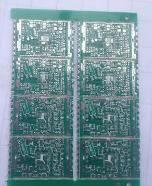The main purpose of PCB baking is to dehumidify and remove moisture, and to remove the moisture contained in the PCB or absorbed from the outside, because some materials used in the PCB itself are easy to form water molecules.
In addition, after the PCB is produced and placed for a period of time, there is a chance to absorb moisture in the environment, and water is one of the main killers of PCB popcorn or delamination.
Because when the PCB is placed in an environment where the temperature exceeds 100°C, such as reflow oven, wave soldering oven, hot air leveling or hand soldering, the water will turn into water vapor and then rapidly expand its volume.
The faster the heating speed of the PCB, the faster the expansion of water vapor; the higher the temperature, the larger the volume of water vapor; when the water vapor cannot escape from the PCB immediately, there is a good chance of expanding the PCB .

In particular, the Z direction of the PCB is the most fragile. Sometimes the vias between the layers of the PCB may be broken, and sometimes it may cause the separation of the layers of the PCB. More seriously, even the appearance of the PCB can be seen. Phenomenon such as blistering, swelling, bursting, etc.;
Sometimes even if the above phenomenon is not visible on the PCB surface, it has actually been internally injured. Over time, it will cause the function of electrical products to be unstable, or CAF and other problems will occur, which will eventually cause the product to fail.
Analysis of the true cause of PCB explosion and preventive countermeasures
The PCB baking procedure is actually quite troublesome. During baking, the original packaging must be removed before it can be put in the oven, and then the temperature must be over 100 degree Celsius for baking, but the temperature should not be too high to avoid the baking period. Excessive expansion of water vapor actually bursts the PCB.
Generally, the PCB baking temperature is generally set at 120±5 degree Celsius in the industry to ensure that moisture can really be eliminated from the PCB body before the SMT line can be used for reflow soldering.
The baking time varies with the thickness and size of the PCB. For thinner or larger PCBs, you have to press the board with a heavy object after baking. This is to reduce or avoid the PCB The tragic occurrence of PCB bending deformation due to stress release during cooling after baking.
Because once the PCB is deformed and bent, there will be offset or uneven thickness when printing solder paste in SMT, which will cause a large number of solder short circuits or empty soldering defects during the subsequent reflow.
PCB baking condition setting
At present, the industry generally sets the conditions and time for PCB baking as follows:
1. The PCB is well sealed within 2 months of the manufacturing date. After unpacking, it is placed in a temperature and humidity controlled environment (≦30 degree Celsius/60%RH, according to IPC-1601) for more than 5 days. Bake at 120±5 degree Celsius for 1 hour.
2. The PCB is stored for 2 to 6 months beyond the manufacturing date, and it must be baked at 120±5°C for 2 hours before going online.
3. The PCB is stored for 6-12 months beyond the manufacturing date, and it must be baked at 120±5°C for 4 hours before going online.
4. PCB is stored for more than 12 months from the manufacturing date, basically it is not recommended, because the adhesive force of the multilayer board will age over time, and quality problems such as unstable product functions may occur in the future, which will increase the market for repairs. In addition, there are risks of plate bursting and poor tin eating during the production process. If you have to use it, it is recommended to bake at 120±5°C for 6 hours. Before mass production, first try to print a few pieces of solder paste and make sure that there is no solderability problem before continuing production.
Another reason is that it is not recommended to use PCBs that have been stored for too long because their surface treatment will gradually fail over time. For ENIG, the industry’s shelf life is 12 months. The thickness depends on the thickness. If the thickness is thinner, the nickel layer may appear on the gold layer due to the diffusion effect and form oxidation, which will affect the reliability, so you should not be careful.
5. All PCBs that have been baked must be used within 5 days, and unprocessed PCBs must be baked at 120±5°C for another 1 hour before going online.
Stacking method during PCB baking
1. When baking large-size PCBs, use a horizontal stacking arrangement. It is recommended that the maximum number of a stack should not exceed 30 pieces. The oven needs to be opened within 10 minutes after the baking is completed to take out the PCB and lay it flat to cool it. Press after baking Anti-bend fixtures. Large-size PCBs are not recommended for vertical baking, as they are easy to bend.
2. When small and medium-sized PCBs are baked, they can be placed horizontally and stacked. The maximum number of a stack should not exceed 40 pieces, or it can be upright, and the number is not limited. You need to open the oven and take out the PCB within 10 minutes after the baking is completed. Allow it to cool, and press the anti-bending jig after baking.